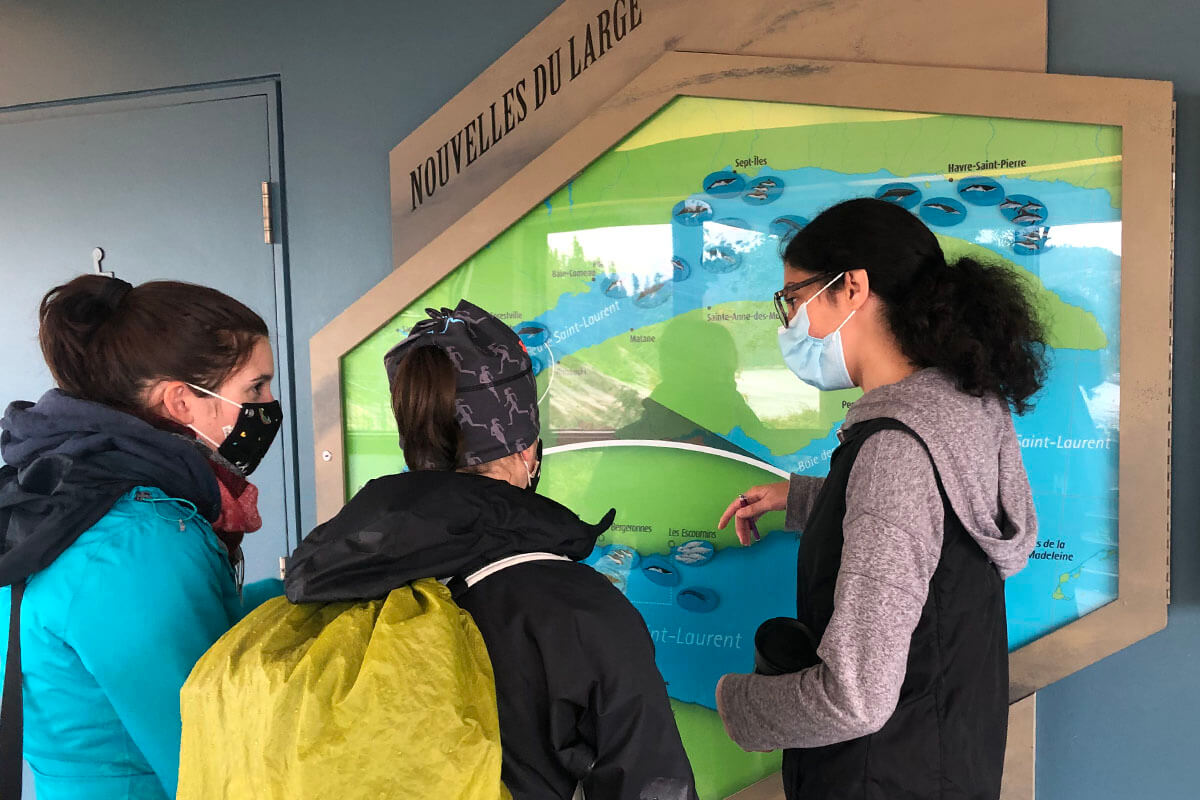Whether on water or on land, the research activities carried out by the Group for Research and Education on Marine Mammals (GREMM) represent an inexhaustible source of “whale tales”, which are often shared in field notes.
However, GREMM’s “education” component also has its fair share of stories! Our team of naturalists therefore invites you totheir playing field – the Marine Mammal Interpretation Centre (CIMM) – for a day in the company of whale skeletons and curious visitors.
Extended observations
10 a.m. We open the CIMM’s doors for the handful of visitors who are already lined up in front of the building to enter. They have taken advantage of their wait to scan the mouth of the Saguenay in search of any small black or white backs that might appear. Inside, another type of whale watching awaits: that of our motionless giants.
After adjusting their masks and disinfecting their hands, the visitors enter the museum. This season is special, marked not only by the implementation of health measures, but especially by the inauguration of an expanded showroom featuring three new whale skeletons. After a lengthy process – including bone preparation, finishing touches and transport – they can finally be admired by visitors since August 1.
Extended contacts
When entering the showroom, most people are amazed by the immensity of the fifteen skeletons on display in front of them. “Because they are hovering above us, it really feels as if we are submerged in water with the whales. It’s really a unique point of view!” insists Laurence, GREMM naturalist for the summer. As she makes her way around the room, a few curious individuals ask her questions about whale anatomy or share their observations from the day before.
This year, only about thirty visitors are permitted at a time, which allows naturalists to offer “a more personalized visit”, notes Aurélie, accustomed to seeing the room packed to maximum capacity (over 100!) last summer. Inevitably, people are concerned by some of the most recent headlines, she notes.
From time to time, visitors in the exhibition turn their attention to Laurence. The sounds coming from the interactive terminals subside as Laurence introduces the skeletons. For nearly 15 minutes, she identifies the species, describes its behaviours and points out its particularities: traces of collisions on the right whale Piper, the false tooth of the sperm whale or the intact fetus of the female minke whale. Through her stories, she brings each of these skeletons to life.
After her presentation draws to a close, the lights go out and the room is filled with the sounds of serenading cetaceans. This is the Whale Ballet, a three-minute sound-and-light activity. “I invite you to contemplate the skeletons and listen to the whale songs and immerse yourself with them,” says the naturalist before switching on the soundtrack of Normand Pierre-Boileau.
Illuminated by lighting technician Caroline Ross, the skeletons almost appear to be moving, revealing their fragility. They are no longer distant giants, tiny backs on the horizon, or even stories, but animals that once roamed the seas. When the lights come back on, it takes a few seconds for visitors – and sometimes the naturalist as well – to return to the reality of the exhibit.
Lights out
6 p.m. After several rounds of presentations, enquiries and wonder, the time has come to close the room. The skeletons and the terminals fade into the darkness as the last of the visitors leave the CIMM filled with their discoveries, and perhaps a new passion. “I think that’s what I love most about being a naturalist: knowing that some people will want to continue learning about marine mammals even after they leave,” says Sarah, naturalist and contributor to Whales Online.
On the way home, the faces encountered in the streets of Tadoussac are the same as those seen earlier in the day. The naturalists are on their way back home, but their work is not quite finished. Motivated by the visitors’ questions and reflections, they embark on research that might inspire an upcoming presentation or a lengthy discussion with their colleagues at CIMM who have become their friends for the summer.








